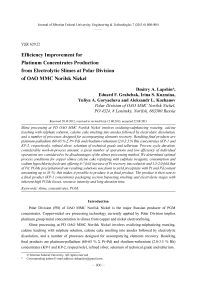Efficiency improvement for platinum concentrates production from electrolytic slimes at polar division of OAO MMC Norilsk Nickel
Автор: Lapshin Dmitry A., Grabchak Eduard F., Kuzmina Irina S., Goryacheva Yuliya A., Kozhanov Aleksandr L.
Журнал: Журнал Сибирского федерального университета. Серия: Техника и технологии @technologies-sfu
Статья в выпуске: 7 т.6, 2013 года.
Бесплатный доступ
Slime processing at PD OAO MMC Norilsk Nickel involves oxidizing-sulphatizing roasting, calcine leaching with sulphate solution, calcine cake smelting into anodes followed by electrolytic dissolution, and a number of processes designed for accompanying elements recovery. Resulting final products are platinum-palladium (60-65 % Σ Pt+Pd) and rhodium-ruthenium (2.0-3.5 % Rh) concentrates (KP-1 and KP-2, respectively), refined silver, selenium of technical grade and tellurium. Process cycle duration, considerable work-in-process amount, a great number of operations and low efficiency of individual operations are considered to be disadvantages of the slimes processing method. We determined optimal process conditions for copper slimes calcine cake repulping with sulphate (reagents, consumption and sodium hypochlorite feed rate) offering 6-7 fold increase of Pt recovery into solution and 1,5-2,0 fold that of Pd. PGMs precipitation from resulting solutions was fount to yield precipitate with Pt and Pd content amounting up to 55 %; this makes it possible to produce it as final product. The product is then sent to a final product (KP-1 concentrate) packaging section bypassing smelting and electrolysis stages with inherent high PGMs losses, resource intensity and long duration time.
Slime, concentrates, pgm
Короткий адрес: https://sciup.org/146114793
IDR: 146114793


